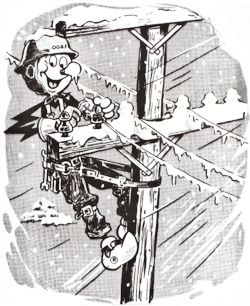 Remember that funny looking guy over there on top of that electricity pole? Sure you do ... that's Reddy Kilowatt, Oklahoma Gas & Electric Company's mascot for half a century — doubtless he's smiling since he didn't have to deal with the city's horrific ice storms during the past couple of years! I'll talk about his forced retirement at the end of this article.
Remember that funny looking guy over there on top of that electricity pole? Sure you do ... that's Reddy Kilowatt, Oklahoma Gas & Electric Company's mascot for half a century — doubtless he's smiling since he didn't have to deal with the city's horrific ice storms during the past couple of years! I'll talk about his forced retirement at the end of this article.Although this article does present some of OG&E's history in the city, the content really doesn't develop the company's history in detail. Instead, the article presents looks at the city that you and I would have had were we OG&E employees, groupies or something along those lines from OG&E's birth in 1902 (actually, a bit earlier than that) through its first half-century or so but with a bit of overlap into the modern era. The primary source for this article is the book, OGE Energy Corp. — Our First 100 Years — 1902-2002 by Robert R. Morris (Donning Company 2002) which provides some absolutely stunning historical photographs of the city during that period of time. Some of those photos are probably not available to be seen from any other source than here unless you also own the out-of-print book.
Expansion to Broadway The Harrah Plant
Middle Years — 1927-1958 No More Gas Relocation To Harvey
Belle Isle Middle Years Photos 1958 Expansion - Today
Reddy Kilowatt & Closing Notes
First Things. Before I get to the point of this article, I'll comment a bit about how I came by its primary source, the book named above. Yesterday, February 12, 2010, I had occasion to follow my nose after venturing downtown on business and the short story is that I wound up driving down Exchange toward Stockyards City looking for a place to eat. Before I got to Agnew, I recalled seeing a sign several weeks ago along that route on the north side of Exchange which read, "Abalache" something. I shelved that tidbit into a mental compartment somewhere but remembered it yesterday as I approached the Stockyards area. "Might that name mean what I thought it might," I wondered to myself? Yesterday, I learned that it did.
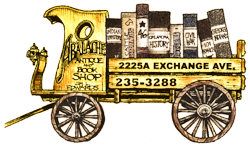 At Right: Hal Ottaway & Jim Edwards from Vanished Splendor (I) (Abalache Book Shop Publishing Co. 1982) | 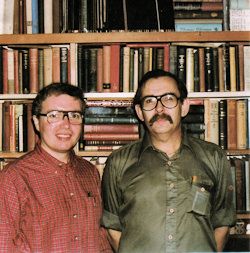 |
I should add this to immediately dispel any notion that he was being rude or unwelcoming which he was not. During the hour or so that I spent in the shop I came to learn that Edwards is a no-nonsense guy, gets right to the point, and has a very dry sense of humor that wouldn't likely be known or perceived on a first impression. As the hour or so took its course, my studied opinion of him came to be that he was, and is, quite pleasant, interesting, and, to be sure, that he is a devotee and treasure trove of Oklahoma City history. He would have to catch himself, however, when a couple of phone callers didn't pick up on his manner, dry humor and straightforward speech — to his credit after recognizing that fact, he assured the callers that what they may have perceived as dismissive or impolite remarks were not to be taken seriously and that he intended no ill will in the manner of his speech.I hope to revisit Mr. Edwards, do an interview and whatever else might follow on a later occasion, but this is enough to say for now. Looking over everything that I could find that I didn't already have and stuff about Oklahoma City history that he had but I didn't, I selected a few purchases.
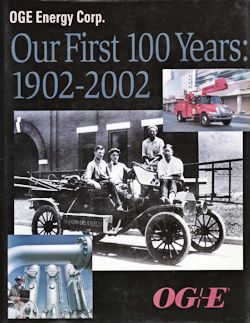 Almost as an afterthought, one was an inexpensive book, that being the OG&E book which is the principal source for this article. I noticed that it was cheap (got it for about $4-$5) and it contained some nice photos of vintage Oklahoma City I'd not seen before. Even though I'm not big on buying books written to serve corporate remembrances, as this one was, at the price and having had a glance at a few of its photos it was impossible not to walk out the door without it.
Almost as an afterthought, one was an inexpensive book, that being the OG&E book which is the principal source for this article. I noticed that it was cheap (got it for about $4-$5) and it contained some nice photos of vintage Oklahoma City I'd not seen before. Even though I'm not big on buying books written to serve corporate remembrances, as this one was, at the price and having had a glance at a few of its photos it was impossible not to walk out the door without it.On looking at the book more closely last night, I quickly saw that I more than easily got the better of the bargain in the transaction. The scans I made of book images shown below will show why I reached that conclusion and I think that you will agree. For each image below, click the image for a larger image, typically 1024 px wide.
BEFORE OG&E. As suggested above, the book actually begins before OG&E's birth in 1902 — it begins with the day that the city came to exist, April 22, 1889.
The Land Run. Have a look at the magnificent photo below showing land runners on and off the Santa Fe train, near where the Santa Fe depot is today.
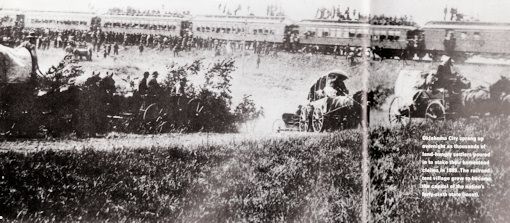
My suspicion is that the above photograph is a composite, not originally just one but two or three photographs which have been blended and pieced together to portray the different kinds of traffic which occurred on that day — buggies, train arrivals and covered wagons — merely to capture the day's essence but I have no evidence of that. Regardless, the powerfulness of the day's events are captured in the above image, be it doctored or not.
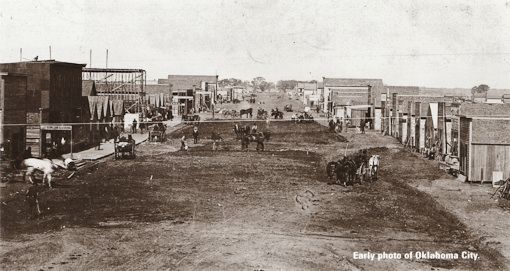
Pretty Little Surrey With The Fringe On The Top
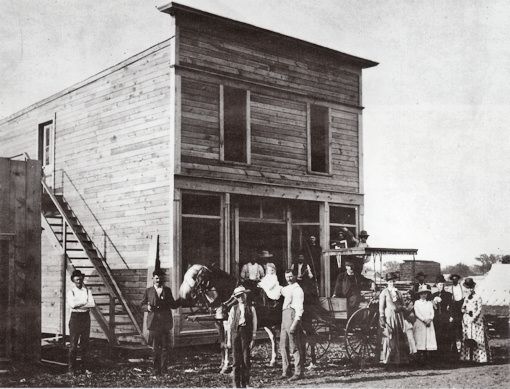
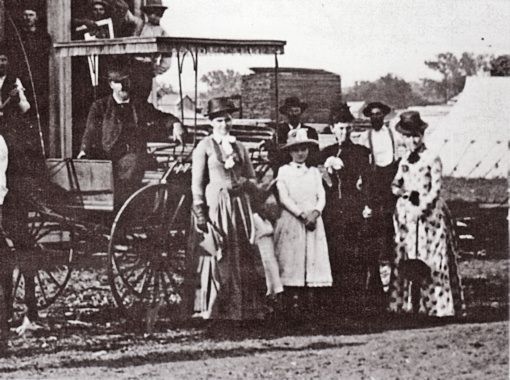
The Failed Canal. The story of the 1889 canal which was intended to produce and provide electricity to the city is told here. A pair of images in the book show canal construction and its associated power plant.

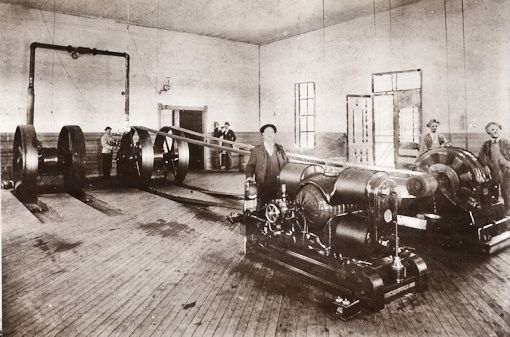
Looking North On Broadway in 1892
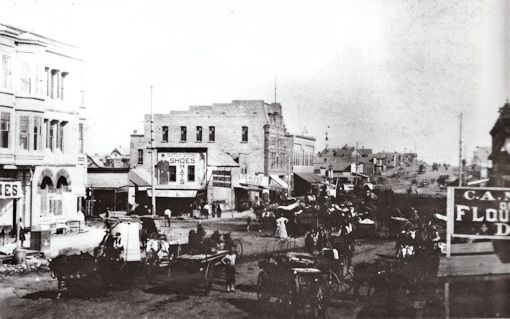
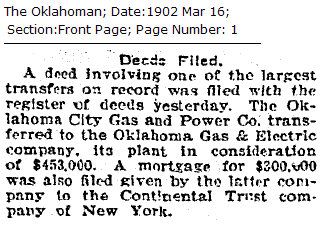 THE EARLY YEARS — 1902 THROUGH 1927. According to the book, the present day OGE Energy Corporation (but which most still call Oklahoma Gas & Electric Company, OG&E) has its start date in 1902. The Daily Oklahoman item shown at right shows that the company purchased the plant of Oklahoma City Gas and Power Co. in March 1902. The book does not identify the location of that plant but says, at page 160,
THE EARLY YEARS — 1902 THROUGH 1927. According to the book, the present day OGE Energy Corporation (but which most still call Oklahoma Gas & Electric Company, OG&E) has its start date in 1902. The Daily Oklahoman item shown at right shows that the company purchased the plant of Oklahoma City Gas and Power Co. in March 1902. The book does not identify the location of that plant but says, at page 160,1902 ● Robinson and Frisco Streets. The original power plant predated incorporation. It was the one and only power facility that used coal to generate as much as seven hundred kilowatts for street lighting and home use.Although I'm making no attempt in this article to make a serious study of OG&E's history, I did want to see where that Robinson & Frisco (SW 5) location was and the most reliable resources I have for that are the Sanborn Maps available via the Oklahoma City Metropolitan Library System. Having a look, I found no energy-related entries in the maps which were located at or near Robinson & Frisco in any of the the 1898, 1901 or 1904 Sanborn Maps (and recognizing that an earlier-than-1902 organization by the same name is not claimed as part of the present organization's lineage). The book's author may not have gotten it wrong, but a basis exists to cause further study before assuming that he got it right.
At page 160, the author appears to mark 1909 as OG&E's new plant's date but that is not correct. The plant was located between Noble (SW 2nd) and Chickasaw (SW 3rd) Avenues east of Broadway and wast of the Santa Fe tracks, and used a Noble Avenue address. However, as noted above, 1898, 1902 and 1904 Sanborn maps already show that location for OG&E, showing a major expansion in the 1904 map. As a benchmark, note that the Cotton Compress was due east of the Noble Avenue location, across the Santa Fe railroad tracks.
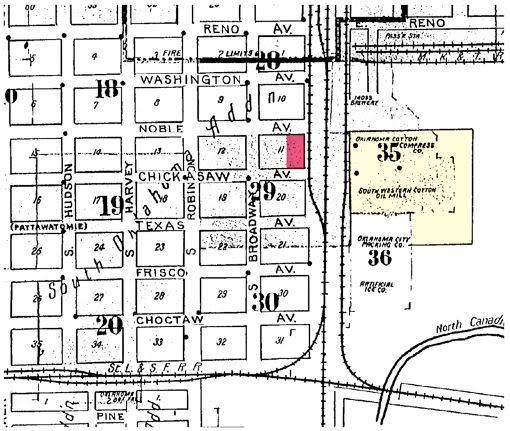

At pages 20-21 the author describes the early, and financially shaky, years of OG&E's existence. Authorized by City Council to provide electricity and gas to the city, the city also granted a natural gas franchise to People's Gas Company (one incorporator of which was Oscar G. Lee) in April 1902 and according to a brief note in the November 3, 1904, Oklahoman it was "rapidly laying its lines in all parts of the city." Litigation by OG&E against that company began in August 1902 but apparently did not ultimately succeed. By April 1905, OG&E purchased its competitor's plant and franchise.
The author traces a few other woes of the early period. One mentioned a notice placed in the October 25, 1902, Daily Oklahoman:
The Oklahoma Gas and Electric Company desires to notify its customers in the resident portion of the city that owing to the heaving load on Saturday nights, it will be necessary to cut out the resident portion of the city from lighting time until ten o'clock. This will have to be done from now on until our new Electric Plant is completed, which we hope to have in operation by November 15, 1902.The author notes that by the end of the year, the situation had not changed.
A more tragic event resulted in the death of a customer. On the evening of January 27, 1903, strong winds blew down an electric service wire. Even though the company engineer was notified, he failed to turn off the power. The next morning, an unsuspecting gentleman went out to retrieve his morning paper, stepped on the live wire, and was killed.
I won't further trace the early ills or the path that was finally taken to cause OG&E to achieve stability and remarkable growth to El Reno, Enid, Muskogee, Ft. Smith, and elsewhere but will simply conclude this early period by saying that the company has a most interesting story to tell and that the author does the telling quite well. The remainder of this part is shown by many of the photos presented during this period.
The photos below show OG&E's first location and early day motor vehicles.
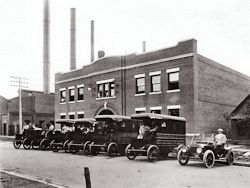 | 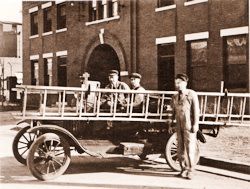 |
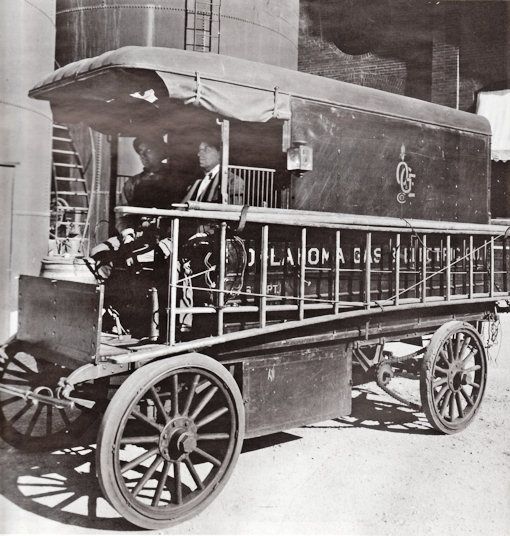
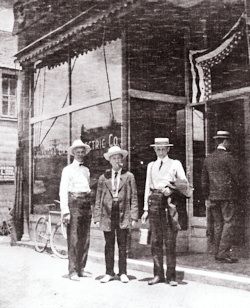 Expansion to Broadway. The company opened its business office at 110 N. Broadway by 1905 at which location it showed its customers the latest gas and electric appliances, some shown below. The 8 story Insurance Building opened in 1910 and in 1911 OG&E became the main tenant in that building, occupying several floors and its distinctive signage marked the location. At right, three company men stand by the Broadway storefront in 1908.
Expansion to Broadway. The company opened its business office at 110 N. Broadway by 1905 at which location it showed its customers the latest gas and electric appliances, some shown below. The 8 story Insurance Building opened in 1910 and in 1911 OG&E became the main tenant in that building, occupying several floors and its distinctive signage marked the location. At right, three company men stand by the Broadway storefront in 1908.The respective locations are shown in the 1906 and 1922 Sanborn maps below.
New Plant Near Harrah. In 1923, construction began at a new power plant sitting inside Horseshoe Lake just north of Harrah in eastern Oklahoma County. Construction was complete in 1924. A pair of 1963 images are also shown in the book.
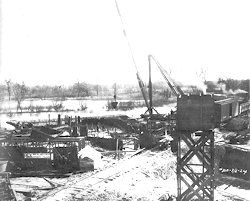 | 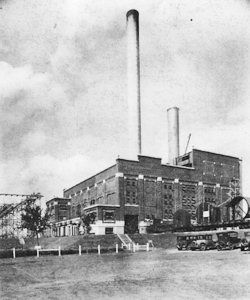 |
1963 | 1963 Inside The Horseshoe Plant 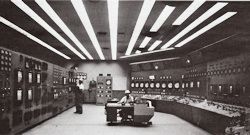 |
THE MIDDLE YEARS — 1927-1958. OG&E joined the onslaught of 1920s new downtown construction by adding its own new fixture to the city's skyline, even if initially it was a modest six-stories high. But, the biggest news was that OG&E effectively dropped "gas" from its offering even though retaining the name in its title.
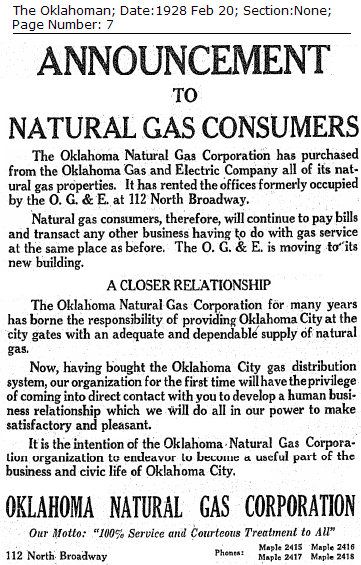 No More Gas. The book gives very little description of the decision except to say that, "Finally in 1928,OG&E made a bold and strategic move by selling all its gas properties in order to focus solely on electric power production and delivery."
No More Gas. The book gives very little description of the decision except to say that, "Finally in 1928,OG&E made a bold and strategic move by selling all its gas properties in order to focus solely on electric power production and delivery."A search of the Oklahoman's articles does reflect what became of the gas — it was acquired by Oklahoma Natural Gas, per the February 20, 1928, article at the right. As you can see from the article, ONG initially rented some of the space OG&E used in the Insurance Building but in 1931 became OG&E's neighbor when it leased space in the 5-story Key Building (formerly the Elks Lodge) which ONG purchased outright in June 1947.
Relocation To NW 3rd & Harvey. In 1927, the company announced that it would construct a new building on one of the highest points in downtown Oklahoma City, Northwest 3rd & Harvey. Although it would initially only be a six-story structure, the building was constructed so that it could double in size (which it would do about 30 years later). An excellent 1927 architectural drawing of the new building, showing its potential, is at page 48 of the book and appears below.
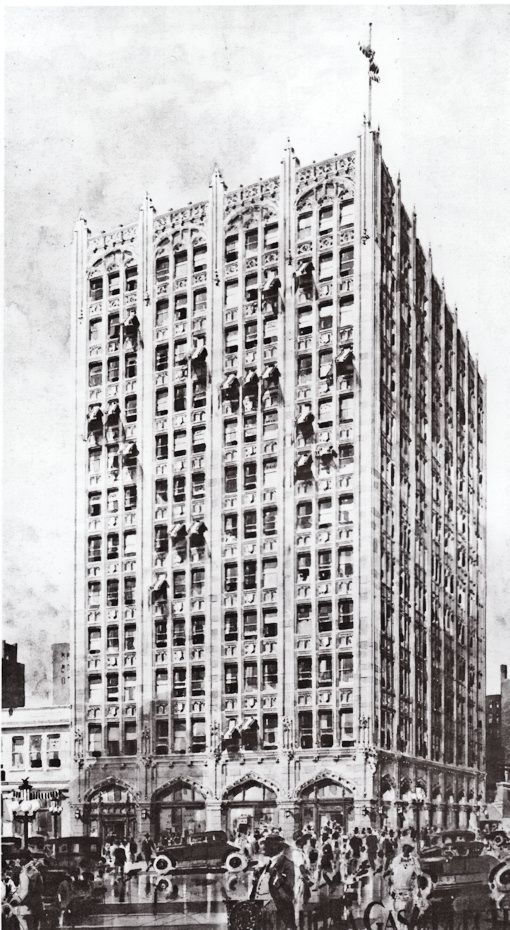
Crop Focusing On Detail
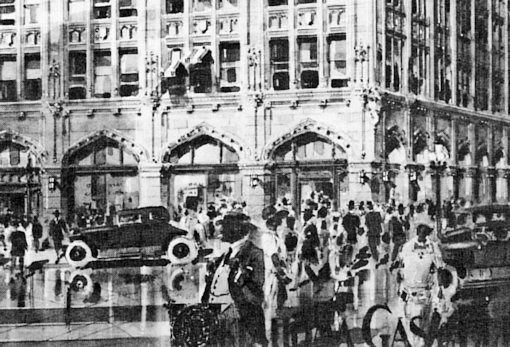
Construction which began in 1927 is shown in the following photo:
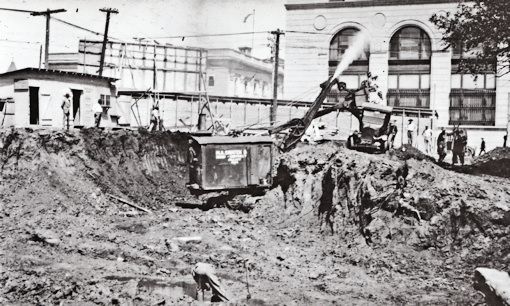
A daytime photo of the new building which had its formal opening on March 18, 1928, is contained in an Oklahoman article:
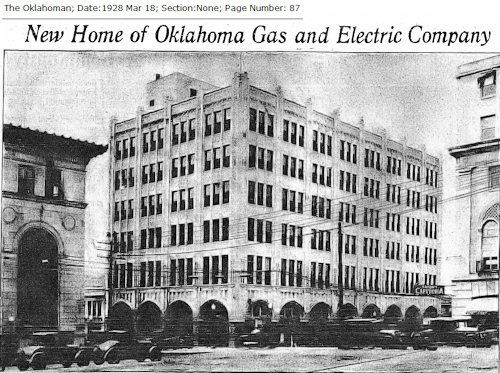
 The accompanying article describes the new building's style as Gothic, finding inspiration from European Gothic cathedrals.
The accompanying article describes the new building's style as Gothic, finding inspiration from European Gothic cathedrals.Click the article's snippet, at right, for a basement to 6th floor detailed description. The article's introduction reads, "Builders of the middle ages who erected in Europe cathedrals and municipal buildings which even today are the glory of that continent, furnished the inspiration for Oklahoma City's latest office building — the new home of the Oklahoma Gas and Electric Company at Third street and Harvey avenue. ¶ The building is of Gothic architecture, modified to meed the requirements of modern commercial use. Its windows and doors on the street-level floor carry out the Gothic arch and Gothic lines in all their purity, and the main lobby and elevator lobby show the influence of long-forgotten craftsmen who labored slowly to create the architectural wonders of medieval times."
1st Christmas At Its New Location
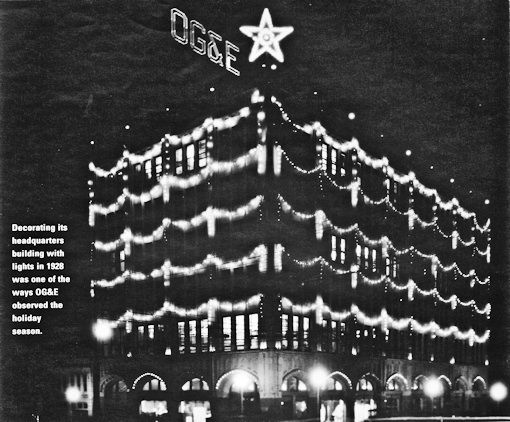
 Belle Isle. In my estimation, a serious criticism and shortcoming of this otherwise fine book is the inattention that it gives to a major piece of Oklahoma City's history, as well of OG&E's, Belle Isle Park — the opportunity to showcase OG&E's connectivity with Oklahoma City and its history was, quite simply, skipped almost entirely. Almost no mention is made of OG&E's purchase of the Belle Isle generating plant from the Oklahoma Railway Company in 1928 — or, in fact, why that plant came to exist in the first place. At page 49, the author states, "The history of OG&E had a famous twist when the Belle Isle property was purchased in 1928. Although no longer functioning when purchased, the land was the site of an amusement park which flourished during the nineteen teens and twenties." That cursory statement is just about all there is in the book about the Belle Isle property.
Belle Isle. In my estimation, a serious criticism and shortcoming of this otherwise fine book is the inattention that it gives to a major piece of Oklahoma City's history, as well of OG&E's, Belle Isle Park — the opportunity to showcase OG&E's connectivity with Oklahoma City and its history was, quite simply, skipped almost entirely. Almost no mention is made of OG&E's purchase of the Belle Isle generating plant from the Oklahoma Railway Company in 1928 — or, in fact, why that plant came to exist in the first place. At page 49, the author states, "The history of OG&E had a famous twist when the Belle Isle property was purchased in 1928. Although no longer functioning when purchased, the land was the site of an amusement park which flourished during the nineteen teens and twenties." That cursory statement is just about all there is in the book about the Belle Isle property.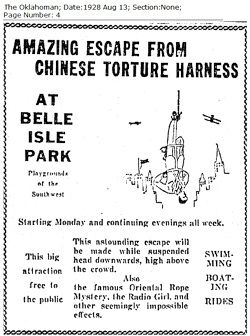 Not only is the slight an error in judgment, what was said about the park not functioning as such at the time of purchase is just plain wrong, as you can see from these two of the many Belle Isle Park ads which appeared through the end of summer 1928.
Not only is the slight an error in judgment, what was said about the park not functioning as such at the time of purchase is just plain wrong, as you can see from these two of the many Belle Isle Park ads which appeared through the end of summer 1928. Although it's true that the younger kid on the amusement park block, Springlake, had by 1928 vastly overtaken Belle Isle Park in the number of rides and popularity, Belle Isle Park's amusements were ended at or shortly after OG&E's purchase of the generating plant. OG&E's business was electricity, not amusements, and it was OG&E that shut down the amusement ride aspects of the park. Also missing is the fact that OG&E continued to maintain and make available to the public, free of charge, those aspects of the park that did not involve rides and other commercial activity.
 The Oklahoma Railway Company purchased the Belle Isle Lake property in the mid-to-late 1900s to deal with a serious problem: its trolley cars were not being supplied with sufficient electricity by OG&E during peak periods and that sometimes resulted in trolley cars and passengers being stranded mid-route. Hence, the trolley and interurban line decided to build its own generating plant at Belle Isle Lake and, while they were at it, make an exceptional recreational area that served the city until 1928, and, in non-amusement park aspects, for decades after that. The ORC plant was operational by 1909, at least.
The Oklahoma Railway Company purchased the Belle Isle Lake property in the mid-to-late 1900s to deal with a serious problem: its trolley cars were not being supplied with sufficient electricity by OG&E during peak periods and that sometimes resulted in trolley cars and passengers being stranded mid-route. Hence, the trolley and interurban line decided to build its own generating plant at Belle Isle Lake and, while they were at it, make an exceptional recreational area that served the city until 1928, and, in non-amusement park aspects, for decades after that. The ORC plant was operational by 1909, at least.At right: New plant construction is announced for Belle Isle in 1929.
Except for the closing photograph in the next series, none are from the book and all images are credited to the Oklahoma Historical Society and can be found in its Star Archives website.
1909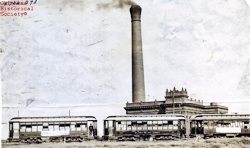 | 1910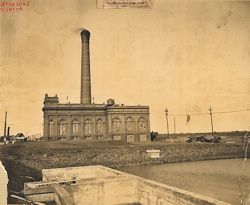 |
1915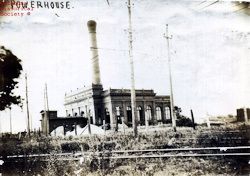 | 1929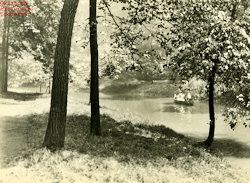 |
1930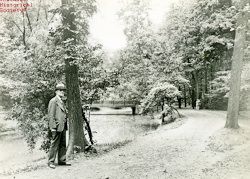 | 1931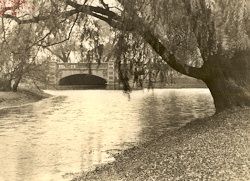 |
1941 Employee Picnic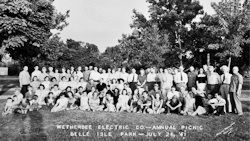 | 1944 |
1945 Inside the Plant | 1945 Inside the Plant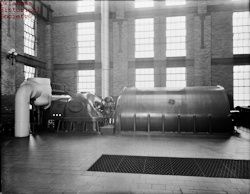 |
1951 Aerial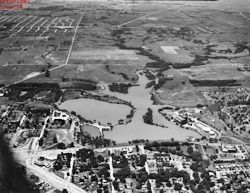 | 1951 Aerial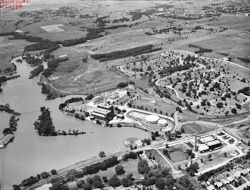 |
Undated Aerial | Undated Aerial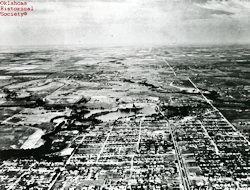 |
Undated Aerial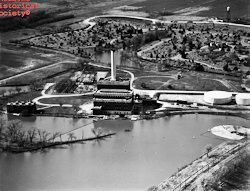 | Undated Aerial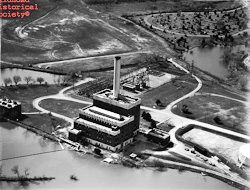 |
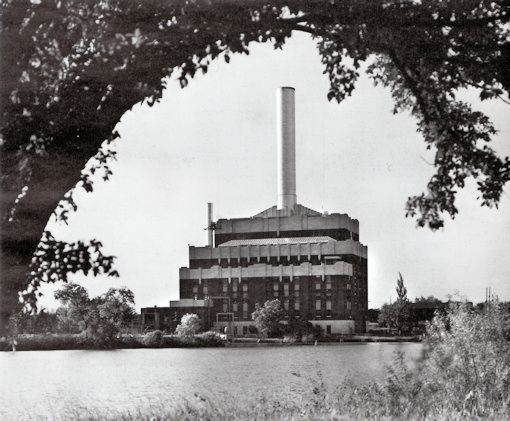
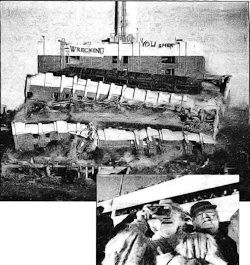 The book's text notes that the plant had become obsolete and inoperable and that it was dismantled and destroyed after 1980. Oklahoman articles provide the missing detail. An April 23, 1980, article reported OG&E's decision to retire the plant later that year. Although proposals were made to save the building and convert it to commercial use, that didn't happen and a January 25, 1999, article reports on the Belle Isle plant's destruction by explosives. Today, a non-iconic Wal-Mart and other strip mall retail outlets occupy the once proud historic space.
The book's text notes that the plant had become obsolete and inoperable and that it was dismantled and destroyed after 1980. Oklahoman articles provide the missing detail. An April 23, 1980, article reported OG&E's decision to retire the plant later that year. Although proposals were made to save the building and convert it to commercial use, that didn't happen and a January 25, 1999, article reports on the Belle Isle plant's destruction by explosives. Today, a non-iconic Wal-Mart and other strip mall retail outlets occupy the once proud historic space.Images During the Middle Years. The book contains several excellent images associated with OG&E and the city and some others, shown below.1958 - 2002. As noted in Relocation to NW 3rd & Harvey, above, when constructed in 1927-28 the company's office building was built with an eye to later possible expansion. Thirty years later, in 1958, the original 6-story corporate headquarters finally got its additional 6-stories and the building we know today was done. However, the author says that by 1987 the historic building was too small to house all corporate office personnel and that in 1992 OG&E leased 250,000 square feet in the new Corporate Tower building on Robinson, south of the Robinson Renaissance Building today. After remodeling its original structure and design in the mid 1990s — including the replacing of many desks and credenzas with ergonomic work stations — on October 5, 1998, the company returned to and has since remained in its historic home.
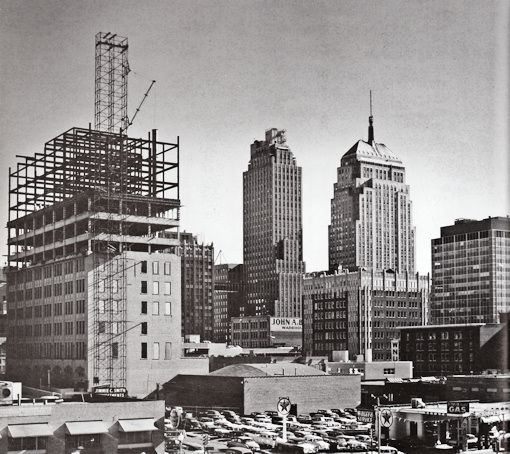
According to the book,
the signage below was removed in 1978
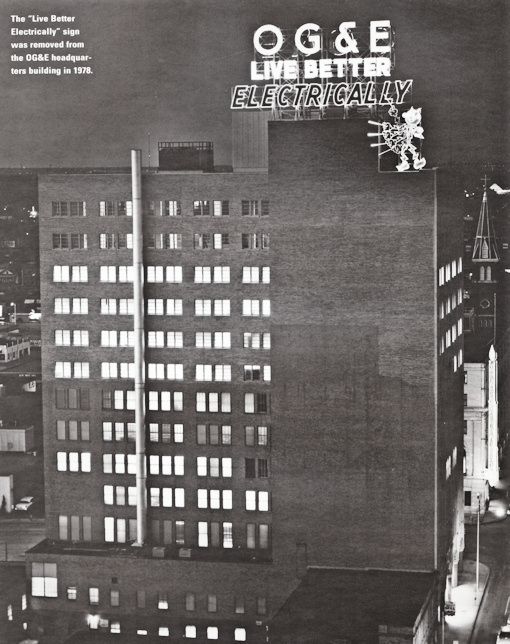
At Corporate Tower 1992 Until 1998
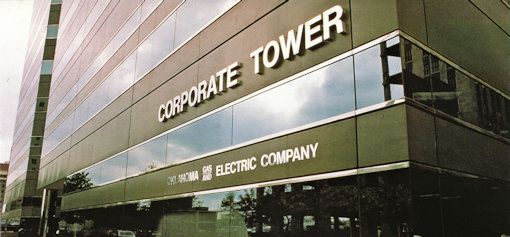
Skyline View In 2002
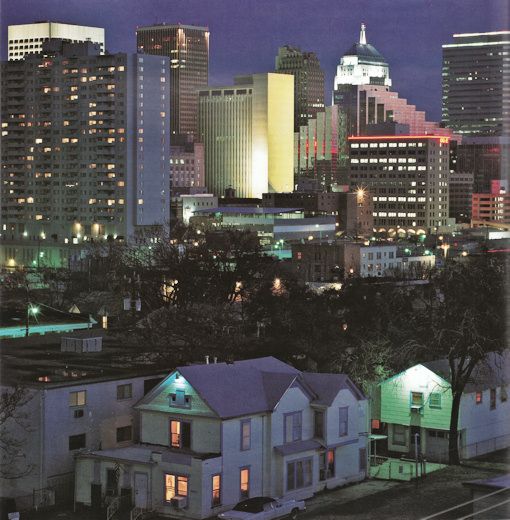
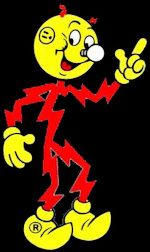
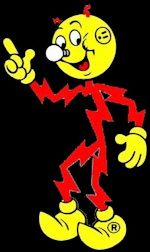 REDDY KILOWATT & CLOSING NOTES. Hey, boys & girls, do you miss me? You know that's what he's wondering, don't you?
REDDY KILOWATT & CLOSING NOTES. Hey, boys & girls, do you miss me? You know that's what he's wondering, don't you?From September 1936 until June 1994, this ubiquitous happy little guy, Reddy Kilowatt, was OG&E's face and ambassador to the public. We saw him in ads, we saw him give us helpful information, we saw him wave a flashing wand on top of the company's corporate building, we saw him climb service poles in winter weather and be happy doing so.
The photo below shows Reddy being hoisted to the top of corporate headquarters in the 1930s ...
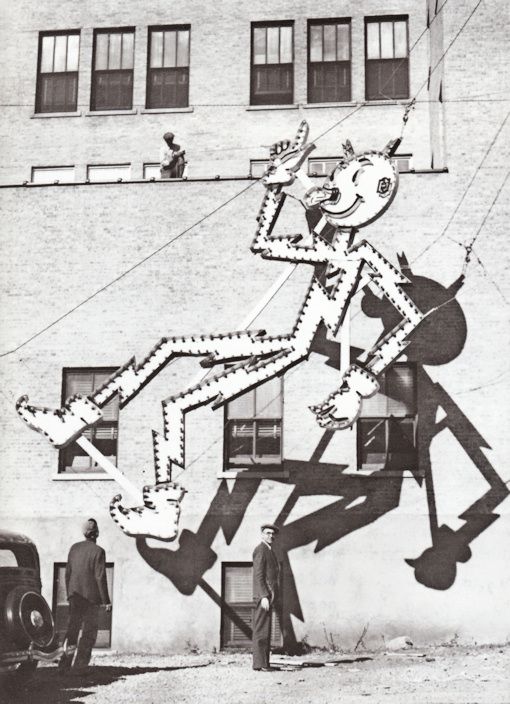
A later version of Reddy sits atop the newer building in the 1960s through 1978, waving his magic electric wand ...
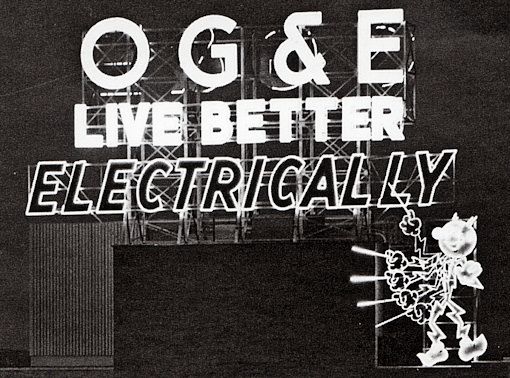
| Purchasing Tips in 1938 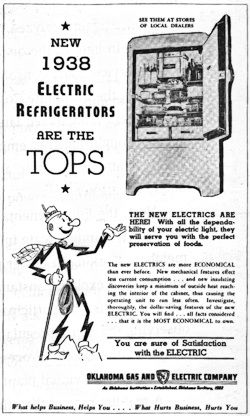 | Dust Storm Tips in 1938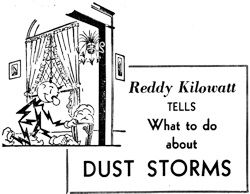 On A Pole in the 1970s 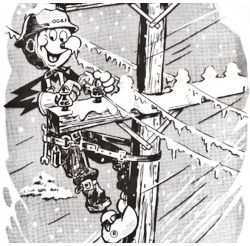 |
Today, in 2010, we in Oklahoma see Reddy no more. What happened to the little guy? The author said, "In the 1990s, times and symbols had changed so that OG&E no longer used Reddy Kilowatt as a corporate mascot."
In researching the Oklahoman's archives I found the following: The last use of Reddy in the company logo that I could find appeared in this June 26, 1994, OG&E ad. Right after that, a July 14 article announced that OG&E had decided to adopt a new logo. A few days later, on on July 29, Oklahoma Gas & Electric Company announced that it had also decided to adopt a new name, OG&E Electric Services, or, more simply for logo purposes, OG+E, including the italics.
Well, the truth is, the company has had numerous logos over its now 108 years of existence and will likely come to have others in the future. But, when OG+E takes a vote for the next change, if I'm asked to participate, I'll be doing a write-in campaign for the little guy at the left, below.
 | vs. |  |

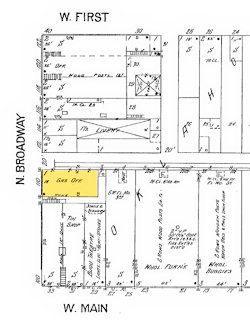
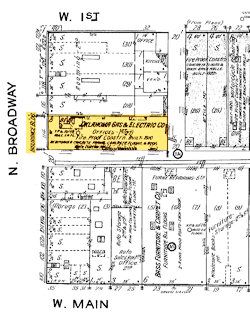

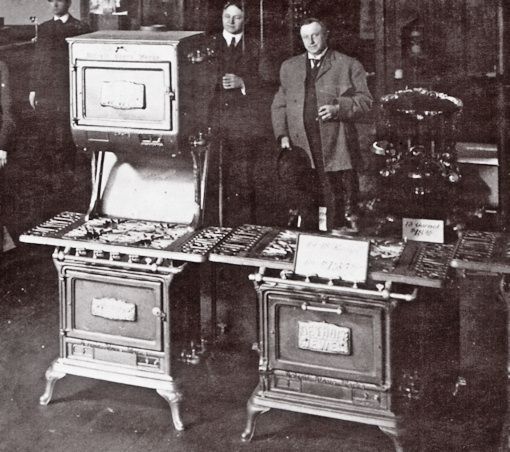
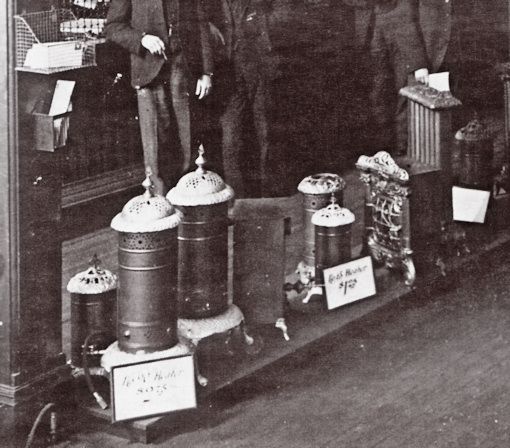
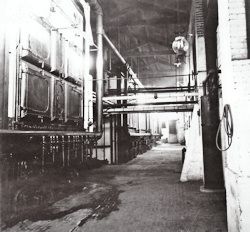
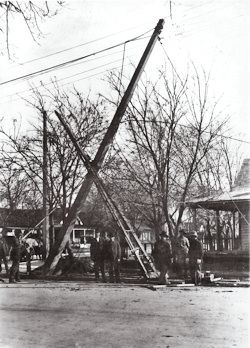
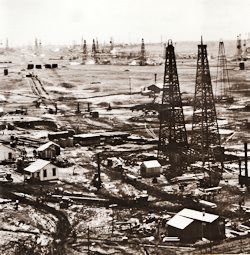
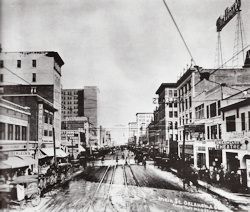
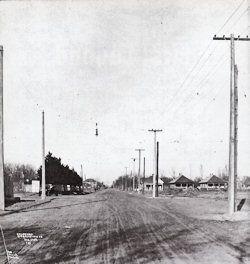
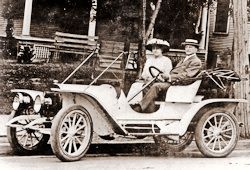
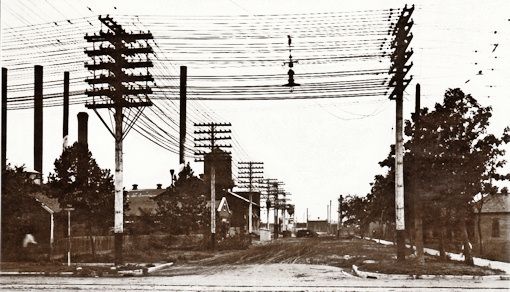
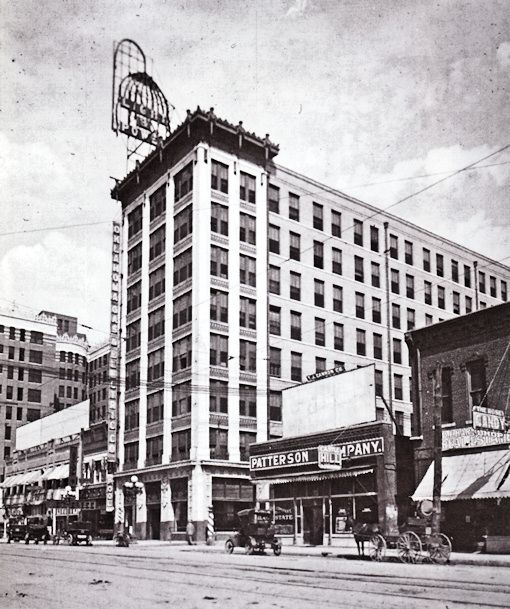
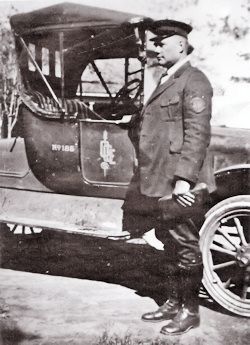


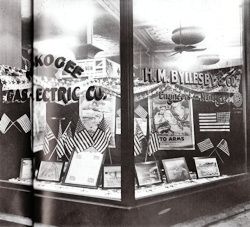

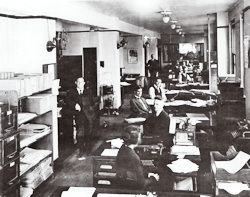
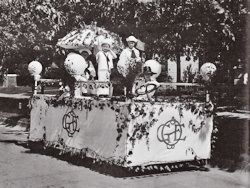
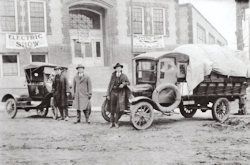
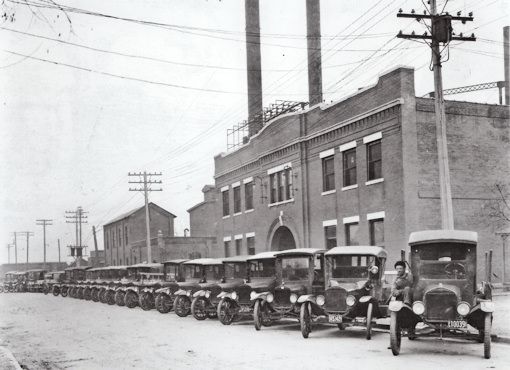
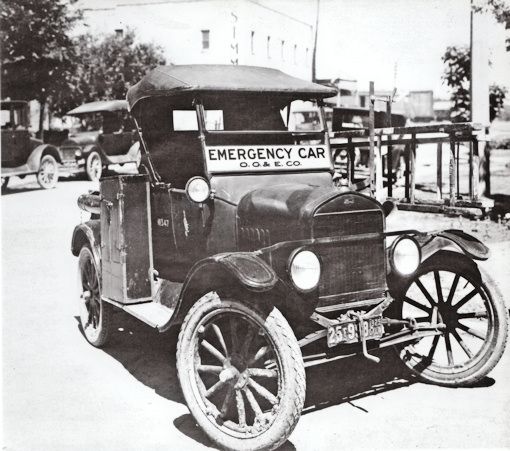
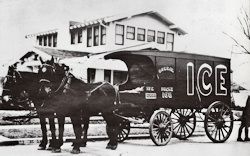


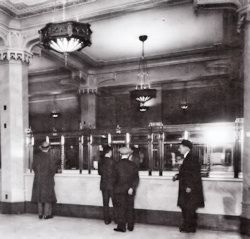

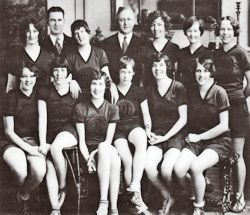
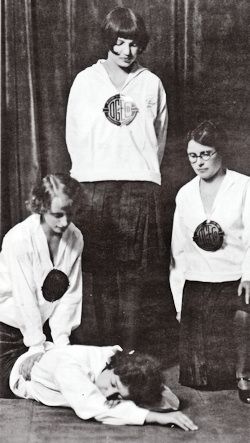
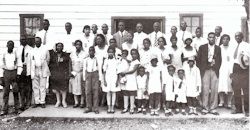
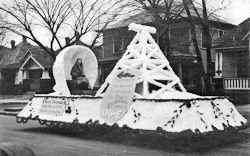
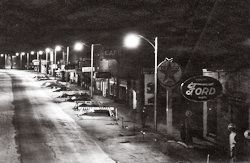














7 comments:
Wow. Stunned by canal construction photo. I never knew a photo of that existed! Wow, wow, wow...
- Steve
Thank you, my friend. I didn't either, until reading through this book ... which is ever so much better in showing history than are some corporation history books. These guys, this author, did it right, and that's all good for legitimate OKC history. He shows the blemishes as well as the better side of things.
Thank you so much for sharing all this great information! I'm also glad to know what happened to Abalache book shop.
Brenda
Thanks, Brenda.
Dawg -
I think the main reason that OG&E quit using the Reddy character was because it is actually copyrighted. In order to continue to use it, OG&E would have to pay a fee so it opted to discontinue it's use.
And yes, it is a bit dated for a modern progressive company like OG&E. Or more correctly OG+E. The plus sign between the G and E shows the "positive energy" in the promotional campaign implemented a few years ago.
Thank you! I've been looking for a cohesive, comprehensive history of the Belle Isle power plant but to no avail. This article is perfect and the information is much appreciated.
Thanks, Hannah.
Post a Comment